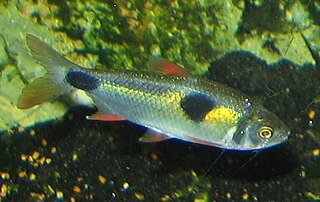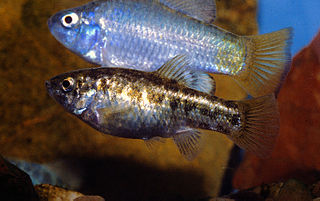
The Death Valley pupfish, also known as Salt Creek pupfish, is a small species of fish in the family Cyprinodontidae found only in Death Valley National Park, California, United States. There are two recognized subspecies: C. s. salinus and C. s. milleri. The Death Valley pupfish is endemic to two small, isolated locations and currently classified as endangered.

The Tecopa pupfish is an extinct subspecies of the Amargosa pupfish. The small, heat-tolerant pupfish was endemic to the outflows of a pair of hot springs in the Mojave Desert of Inyo County, California. Habitat modifications, the introduction of non-native species and hybridization with the related Amargosa River pupfish led to its extinction around 1979.
The Shoshone pupfish is a subspecies of Cyprinodon nevadensis from California in the United States. It is characterized by large scales and a "slab-sided," narrow, slender body, with the arch of the ventral contour much less pronounced than the dorsal. It also has fewer pelvic fin rays and scales than the other subspecies of C. nevadensis.

The Devils Hole pupfish is a critically endangered species of the family Cyprinodontidae (pupfishes) found only in Devils Hole, a water-filled cavern in the US state of Nevada. It was first described as a species in 1930 and is most closely related to C. nevadensis and the Death Valley pupfish. The age of the species is unknown, with differing analyses offering ranges between one thousand and sixty thousand years. It is a small fish, with maximum lengths of up to 30 mm (1.2 in). Individuals vary in coloration based on age and sex: males are bright metallic blue while females and juveniles are more yellow. A defining trait of this species is its lack of pelvic fins. The pupfish consumes nearly every available food resource at Devils Hole, including beetles, snails, algae, and freshwater crustaceans, with diet varying throughout the year. It is preyed on by the predaceous diving beetle species Neoclypeodytes cinctellus, which was first observed in Devils Hole in 1999 or 2000. Reproduction occurs year-round, with spikes in the spring and fall. Females produce few eggs, though, and the survivorship from egg to adult is low. Individuals live 10–14 months.

Pupfish are a group of small killifish belonging to ten genera of the family Cyprinodontidae of ray-finned fish. Pupfish are especially noted for being found in extreme and isolated situations. They are primarily found in North America, South America, and the Caribbean region, but Aphanius species are from southwestern Asia, northern Africa, and southern Europe. As of August 2006, 120 nominal species and 9 subspecies were known. Several pupfish species are extinct and most extant species are listed. In the U.S., the most well-known pupfish species may be the Devils Hole pupfish, native to Devils Hole on the Nevada side of Death Valley National Park. Since 1995 the Devils Hole pupfish has been in a nearly steady decline, where it was close to extinction at 35–68 fish in 2013.

Cyprinodon is a genus of pupfishes found in waters that range from fresh to hypersaline. The genus is primarily found in Mexico, the Caribbean Islands and southern United States, but C. variegatus occurs as far north as Massachusetts and along the entire Gulf of Mexico coastline, and C. dearborni and C. variegatus are found in northern South America. Many species have tiny ranges and are highly threatened, in some cases already extinct. Cyprinodon are small; the largest reaches 10 cm (3.9 in) in length and most other species only reach about half that size.

The sheepshead minnow, also known as sheepshead pupfish, is a species of ray-finned fish in the family Cyprinodontidae, the pupfishes. It is found in salt marsh and estuary environments and is native to the eastern coasts of North and Central America.

Lepidophagy is a specialised feeding behaviour in fish that involves eating the scales of other fish. Lepidophagy is widespread, having evolved independently in at least five freshwater families and seven marine families. A related feeding behavior among fish is pterygophagy: feeding on the fins of other fish.
Robert Rush Miller was an important figure in American ichthyology and conservation from 1940 to the 1990s."
Cyprinodon ceciliae is an extinct species of pupfish. It was endemic to the Ojo de Agua la Presa in southwestern Nuevo Leon state in Mexico, but disappeared in 1990 due to habitat loss. The same freshwater spring system was the home of three other pupfish: Cyprinodon inmemoriam (extinct), Cyprinodon longidorsalis and Cyprinodon veronicae. Although these were from the same spring system, each was restricted to its own individual spring and associated waters. The exact spring and associated waters inhabited by the Villa Lopez pupfish were also the home of a now-extinct, undescribed species of Cambarellus crayfish. The specific name honours the daughter of María de Lourdes Lozano-Vilano and niece of Salvador Contreras-Balderas, Cecilia Contreras Lozano, who assisted on the trip on which the type was collected.
The Carbonera pupfish, also known as the Perrito de carbonera, is a small, endangered species of pupfish in the family Cyprinodontidae. It is endemic to springs and associated waters at Bolsón de los Muertos in northwestern Chihuahua, Mexico. It was last rated by the IUCN in 1996 where considered endangered, but most subpopulations now appear to be extirpated, while a few are extinct in the wild. In 2012, it only survived in the wild in a single spring, which also was the last remaining habitat for the largemouth shiner and the dwarf crayfish Cambarellus chihuahuae. As this single spring was declining, it was decided to move some individuals of all three species to a nearby refuge in 2014 as a safeguard.
The Cachorrito de la Trinidad, also known in English as the Charco Azul pupfish, was a small species of fish in the family Cyprinodontidae. It was endemic to Ojo de Agua la Presa in southwestern Nuevo Leon state in Mexico, but became extinct in 1985 due to habitat loss. The same freshwater spring system was the home of three other pupfish: Cyprinodon ceciliae (extinct), Cyprinodon longidorsalis and Cyprinodon veronicae. Although these were from the same spring system, each was restricted to its own individual spring pool. The spring pond inhabited by the Charco Azul pupfish was also the home of a now-extinct, undescribed species of Cambarellus crayfish. The specific name inmemoriam means "in memory" and signifies the extinction of the species due to its native spring being dried out by groundwater extraction soon after the discovery of this fish in 1983.
Cyprinodon longidorsalis, the cachorrito de charco palmal or La Palma pupfish, is a species of fish in the family Cyprinodontidae. It was endemic to the Ojo de Agua la Presa in southwestern Nuevo Leon state in Mexico, but became extinct in the wild in 1994 due to habitat loss. The same freshwater spring system was the home of three other pupfish: Cyprinodon ceciliae (extinct), Cyprinodon inmemoriam (extinct) and Cyprinodon veronicae. Although these were from the same spring system, each was restricted to its own individual spring pool. The Charco La Palma pool and its spring had a combined area of about 10 m2 (110 sq ft) and was no more than 1.4 m at the deepest point, making the range of the La Palma pupfish perhaps the smallest known for any vertebrate species. This tiny spring pond also was the home of a now-extinct, undescribed species of Cambarellus crayfish.
The Maya pupfish, known in Spanish as cachorrito gigante, is a highly threatened species of fish in the family Cyprinodontidae. It is endemic to Lake Chichancanab in Quintana Roo, Mexico. In almost all places, different Cyprinodon species do not overlap in their range, but there are two notable exceptions and one of these is Lake Chichancanab, which is inhabited by C. maya, C. beltrani, C. esconditus, C. labiosus, C. simus, C. suavium and C. verecundus. Living together, the Cyprinodon species in Lake Chichancanab have diverged into different niches. Pupfish typically feed on algae and detritus. In Lake Chichancanab, however, C. maya has become not only the largest species in the genus Cyprinodon, up to 10 cm (3.9 in) long, but also the only that catches and eats whole fish. In smaller quantities it eats ostracods and freshwater snails.

The Pecos pupfish is a species of pupfish in the family Cyprinodontidae. It is endemic to the Pecos River watershed in eastern New Mexico and western Texas in the United States.

The Owens pupfish is a rare species of fish in the family Cyprinodontidae, the pupfish. It is endemic to California in the United States, where it is limited to the Owens Valley. It is a federally listed endangered species of the United States. This pupfish is up to 5 centimetres long, the largest males sometimes longer. The male is blue-gray, turning bright blue during spawning. The female is greenish brown with a silvery or whitish belly.
The Charco Palma pupfish is a species of small fish in the family Cyprinodontidae. It is endemic to the Ojo de Agua la Presa in southwestern Nuevo Leon state in Mexico. Although listed as critically endangered by the IUCN in 1996, the species is now extinct in the wild. The same freshwater spring system was the home of three other pupfish: Cyprinodon ceciliae (extinct), Cyprinodon inmemoriam (extinct) and Cyprinodon longidorsalis. Although these were from the same spring system, each was restricted to its own individual spring and associated waters. The exact spring and associated waters inhabited by the Charco Palma pupfish were also the home of three now-extinct invertebrates: An undescribed species of Cambarellus crayfish, the valvatid freshwater snail Valvata beltrani and an undescribed species of valvatid freshwater snail. The specific name honours the niece of María de Lourdes Lozano-Vilano and daughter of Salvador Contreras-Balderas, Verónica Contreras Arqueita, who assisted on the trip on which the type was collected.

The desert pupfish is a rare species of bony fish in the family Cyprinodontidae. It is a small fish, typically less than 7.62 cm (3 in) in length. Males are generally larger than females, and have bright-blue coloration, while females and juveniles are silvery or tan. A notable attribute of the desert pupfish is their ability to survive in environments of extreme salinity, pH, and temperature, and low oxygen content. The desert pupfish mates in a characteristic fashion, wherein compatible males and females will come in contact and collectively jerk in an s-shape. Each jerk typically produces a single egg that is fertilized by the male and deposited in his territory. Breeding behavior includes aggressive arena-breeding and more docile consort-pair breeding.
The Saratoga Springs pupfish is a subspecies of the Amargosa pupfish of the family Cyprinodontidae. The native population is endemic to Saratoga Springs, a small wetland in Death Valley National Park in the United States.

Cyprinodon nevadensis is a species of pupfish in the genus Cyprinodon. The species is also known as the Amargosa pupfish, but that name may also refer to one subspecies, Cyprinodon nevadensis amargosae. All six subspecies are or were endemic to very isolated locations in the Mojave Desert of California and Nevada.










